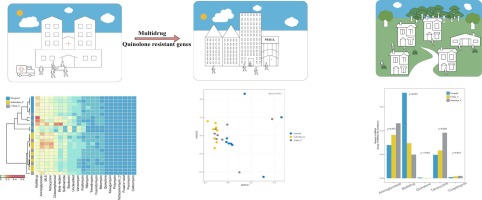当前位置:
X-MOL 学术
›
Environ. Int.
›
论文详情
Our official English website, www.x-mol.net, welcomes your
feedback! (Note: you will need to create a separate account there.)
Characteristics of and variation in airborne ARGs among urban hospitals and adjacent urban and suburban communities: A metagenomic approach.
Environment International ( IF 10.3 ) Pub Date : 2020-04-03 , DOI: 10.1016/j.envint.2020.105625 Peng He 1 , Yan Wu 1 , Wenzhong Huang 2 , Xinwei Wu 1 , Jiayun Lv 1 , Pengda Liu 1 , Li Bu 1 , Zhijun Bai 1 , Shouyi Chen 1 , Wenru Feng 1 , Zhicong Yang 1
Environment International ( IF 10.3 ) Pub Date : 2020-04-03 , DOI: 10.1016/j.envint.2020.105625 Peng He 1 , Yan Wu 1 , Wenzhong Huang 2 , Xinwei Wu 1 , Jiayun Lv 1 , Pengda Liu 1 , Li Bu 1 , Zhijun Bai 1 , Shouyi Chen 1 , Wenru Feng 1 , Zhicong Yang 1
Affiliation

|
Environmental antibiotic resistance genes (ARGs) have received much attention, while the characteristics of ARGs carried by particulate matter (PM) as a function of urban functional region are almost unknown. In this study, ARGs carried by PM2.5 and PM10 in an urban hospital, a nearby urban community and the nearest suburban community were detected using metagenomics. In total, 643 ARG subtypes belonging to 22 different ARG types were identified. The chloramphenicol exporter gene, sul1, bacA, and lnuA were the most abundant ARG subtypes in all air samples. The hospital exhibited higher ARG abundance and richness than the nearby communities. ARG profiles depended on functional region: hospital and suburban samples clustered separately, and samples from the nearby urban community interspersed among them. The representation of multidrug and quinolone resistance genes decayed with distance from the hospital to the urban community to the suburban community, indicating that hospital PM may be a hotspot for ARGs encoding proteins conferring multidrug and quinolone resistance. Airborne ARGs carried by PM in the hospital environment were more closely associated with clinically important pathogens than were those in nearby communities. In particular, carbapenemase genes, including blaNDM,blaKPC,blaIMP,blaVIM,and blaOXA-48, were discovered in hospital PM. In the suburban community, crAssphage, a human host-specific bacteriophage, was applied to predict ARG abundance and found to be enriched due to anthropogenic pollution but showed no clear evidence for ARG selection. In the hospital and the nearby urban community, the drivers of ARGs were complex. Our results highlighted that PM ARGs were closely related to human activities and revealed a potential hotspot, which could provide new evidence for further research and consequently mitigate the formation of airborne ARGs and transfer risks.
中文翻译:

城市医院及邻近城市和郊区社区中机载ARG的特征和变异:宏基因组学方法。
环境抗生素抗性基因(ARGs)已引起广泛关注,而由颗粒物(PM)携带的ARGs随城市功能区而变的特征几乎是未知的。在这项研究中,使用宏基因组学检测了PM2.5和PM10在城市医院,附近的城市社区和最近的郊区社区中携带的ARG。总共鉴定出643种属于22种不同ARG类型的ARG亚型。在所有空气样本中,氯霉素输出基因sul1,bacA和lnuA是最丰富的ARG亚型。与附近社区相比,该医院的ARG丰度和丰富度更高。ARG配置文件取决于功能区域:医院和郊区样本分别聚集,并且附近的城市社区样本散布在其中。从医院到城市社区再到郊区社区,多药和喹诺酮抗药性基因的表达随着距离的增加而衰减,这表明医院的PM可能是ARGs的热点,而ARGs编码赋予多药和喹诺酮抗药性的蛋白质。与附近社区相比,医院环境中PM携带的机载ARG与临床上重要的病原体关系更密切。尤其是在医院的PM中发现了碳青霉烯酶基因,包括blaNDM,blaKPC,blaIMP,blaVIM和blaOXA-48。在郊区社区,人宿主特异性噬菌体crAssphage被用于预测ARG的丰度,并由于人为污染而被富集,但并未显示出选择ARG的明确证据。在医院和附近的城市社区,ARG的驱动因素很复杂。
更新日期:2020-04-03
中文翻译:

城市医院及邻近城市和郊区社区中机载ARG的特征和变异:宏基因组学方法。
环境抗生素抗性基因(ARGs)已引起广泛关注,而由颗粒物(PM)携带的ARGs随城市功能区而变的特征几乎是未知的。在这项研究中,使用宏基因组学检测了PM2.5和PM10在城市医院,附近的城市社区和最近的郊区社区中携带的ARG。总共鉴定出643种属于22种不同ARG类型的ARG亚型。在所有空气样本中,氯霉素输出基因sul1,bacA和lnuA是最丰富的ARG亚型。与附近社区相比,该医院的ARG丰度和丰富度更高。ARG配置文件取决于功能区域:医院和郊区样本分别聚集,并且附近的城市社区样本散布在其中。从医院到城市社区再到郊区社区,多药和喹诺酮抗药性基因的表达随着距离的增加而衰减,这表明医院的PM可能是ARGs的热点,而ARGs编码赋予多药和喹诺酮抗药性的蛋白质。与附近社区相比,医院环境中PM携带的机载ARG与临床上重要的病原体关系更密切。尤其是在医院的PM中发现了碳青霉烯酶基因,包括blaNDM,blaKPC,blaIMP,blaVIM和blaOXA-48。在郊区社区,人宿主特异性噬菌体crAssphage被用于预测ARG的丰度,并由于人为污染而被富集,但并未显示出选择ARG的明确证据。在医院和附近的城市社区,ARG的驱动因素很复杂。











































 京公网安备 11010802027423号
京公网安备 11010802027423号